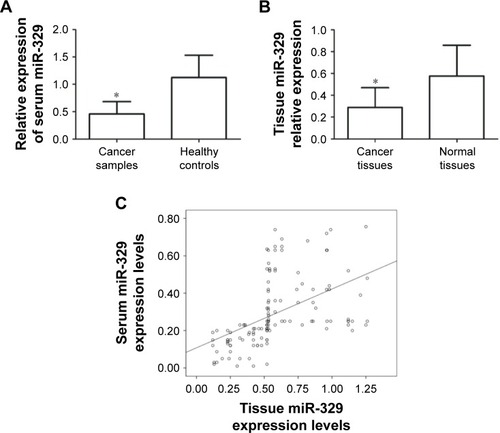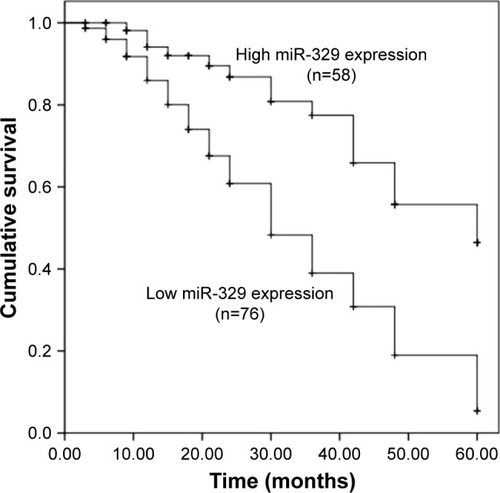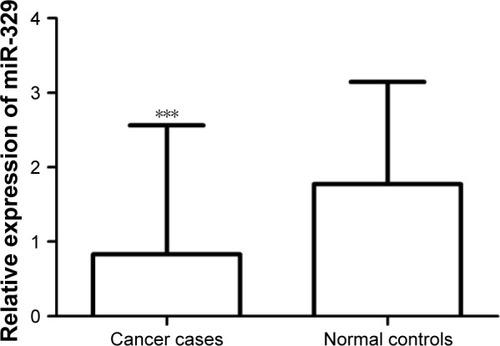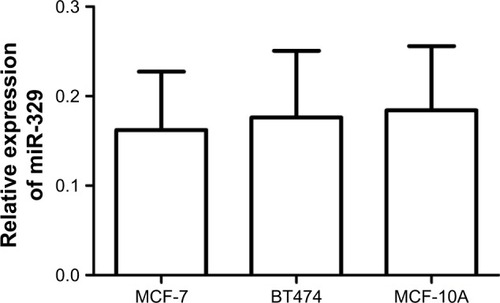Abstract
This study was aimed to assess the expression and clinical performance of microRNA-329 (miR-329) in breast cancer. We recruited 134 breast cancer patients and 70 healthy volunteers for this study. MiR-329 expression was estimated by quantitative real-time polymerase chain reaction. A receiver operating characteristic assay was performed to evaluate the diagnostic value of serum miR-329. In addition, the prognostic significance of miR-329 was evaluated through Kaplan–Meier survival and Cox regression analyses. According to quantitative real-time polymerase chain reaction, miR-329 expression was downregulated in cancerous samples compared with healthy and normal controls (P<0.01), and its expression in serum specimens positively correlated with its expression in tissue samples (R=0.493, P<0.001). The decreased expression of miR-329 correlated with lymph node metastasis (P=0.015) and TNM stage (P=0.003). A receiver operating characteristic curve with an area under the curve of 0.932 was constructed, indicating the high diagnostic accuracy of miR-329. From the survival and multivariate Cox assays, we found that downregulated miR-329 expression was associated with poor overall survival (log-rank P<0.001) and served as an independent prognostic factor (hazard ratio =2.987, 95% CI =1.681–5.308, and P<0.001). In silico analysis using The Cancer Genome Atlas confirmed that miR-329 expression was lower in breast cancer cases compared with normal controls (P<0.001) and could be an efficient biomarker for cancer patients. Down-regulated miR-329 expression was an effective diagnostic and prognostic biomarker, which could be used for targeted therapy in patients with breast cancer.
Introduction
Breast cancer is a worldwide health burden. It represents one of the most common malignancies among females and leads to a reduced quality of life in cancer patients.Citation1 Statistics published by the World Health Organization indicate that there are ~70 newly diagnosed breast cancer cases among every 100,000 individuals annually in North America, Europe, and other countries.Citation2 Some risk factors have been identified, such as lack of breastfeeding and dietary patterns, which are closely correlated with tumorigenesis of breast cancer.Citation3–Citation5 Therefore, many studies focusing on the treatment of breast cancer have been carried out. Although the mortality rate of this malignancy has been decreased thanks to the advances in therapeutic strategies, the prognoses and outcomes of breast cancer patients remain less than ideal.Citation6,Citation7 Previous data revealed that some patients with breast cancer present metastasis in the initial diagnosis, leading to poor outcomes and high mortality.Citation8 Thus, improvement in diagnosis and prognosis is urgently needed for better management of breast cancer.
To improve cancer treatment, a great deal of cancer-related molecules and genes have been investigated to serve as useful biomarkers in various human malignancies.Citation9,Citation10 MicroRNAs (miRNAs), a series of small endogenous RNAs, are considered to be the crucial members among all the available molecular markers.Citation11,Citation12 They can regulate gene expression by binding to the 3′-untranslated regions of target mRNAs.Citation13 MiRNAs have also been reported to be involved in a wide array of biological processes.Citation14 In human cancers, aberrant expression levels of miRNAs have been detected, indicating that they may have special roles during tumor progression.Citation15 Furthermore, the application of miRNAs has received increasing attention for their crucial clinical significance in cancers.Citation16 Therefore, the identification of more functional miRNAs is critical for cancer treatment. MicroRNA-329 (miR-329) is clinically significant in some human cancers, such as glioblastoma and hepatocellular carcinoma.Citation17,Citation18 In addition, significantly downregulated miR-329 expression has been detected in breast cancer samples.Citation19 Thus, we questioned whether there was a relationship between miR-329 expression and breast cancer diagnosis and prognosis.
In this study, we sought to assess the expression patterns of miR-329 in breast cancer samples and to investigate its correlation with tumor progression. In addition, the diagnostic and prognostic values of miR-329 were explored in patients with breast cancer.
Materials and methods
Patients and specimens collection
All the experimental procedures were approved by the Ethics Committee of Wenzhou Medical University. Informed consent was signed by each participant. A total of 134 patients who were histologically diagnosed with breast cancer at the Second Affiliated Hospital of Wenzhou Medical University between January 2006 and December 2010 were included in this study. In addition, 70 healthy volunteers were recruited in our research to act as healthy controls. All these healthy cases were selected from individuals who had routine physical examinations in the hospital without any history of malignancy. None of the breast cancer patients had ever received any therapy prior to the sampling. Venous blood samples were collected from all the participants and then centrifuged to obtain serum specimens. A total of 134 paired breast cancer tissues and adjacent normal breast tissues were isolated from the breast cancer patients during the surgical resection, immediately stored in liquid nitrogen, and kept at −80°C in an ultrafreezer. Concurrently, clinicopathological characteristics of these patients were summarized for subsequent analysis; they are shown in . A 5-year follow-up survey was conducted following the surgical resection for each of the patients, and their survival times were recorded.
Table 1 Association of miR-329 with the clinicopathological features of breast cancer patients
Cell culture and exosomes collection
The human breast cancer cell lines MCF-7 and BT474 and a normal breast epithelial cell line MCF-10A were obtained from the American Type Culture Collection (ATCC, Manassas, VA, USA) and cultured in RPMI-1640 medium supplemented with 10% fetal bovine serum. Cell cultures were incubated in a humidified incubator with 5% CO2 at 37°C. The exosomes were isolated from the cell culture medium using ultracentrifugation and then stored at −80°C for further analyses.
RNA extraction and qRT-PCR
The extraction of total RNA was performed by using TRIzol reagent® (Invitrogen, Carlsbad, CA, USA) following manufacturer’s instructions. The expression of miR-329 was measured using quantitative real-time polymerase chain reaction (qRT-PCR). Single-stranded cDNA, which was synthesized from RNA using the AMV reverse transcription system (Promega, Madison, WI, USA), was used as the template for qPCR. The qRT-PCR was performed with SYBR® Green PCR master mix (Applied Biosystems, Foster City, CA, USA), and all the reactions were run on the 7300 Real-Time PCR System (Applied Biosystems, Foster City, CA, USA) with U6 as the internal control gene. The sequences of primers used in this assay were as follows: miR-329 forward, 5′-GGGAACACACCTGGTTAAC-3′; reverse, 5′-CAGTGCGTGTCGTGGAGT-3′; U6 forward, 5′-CTCGCTTCGGCAGCACATATACT-3′; and reverse, 5′-ACGCTTCACGAATTTGCGTGTC-3′. The final relative miR-329 expression was computed with the 2−ΔΔCt method and normalized to U6.
In silico analysis of miR-329 using TCGA database
The expression levels of miR-329 and clinical information of 755 breast cancer cases were downloaded from The Cancer Genome Atlas (TCGA) database. In addition, the corresponding information of 74 normal controls was collected for the analyses.
Statistical analysis
The differences between the two groups were compared using Student’s t-test. The relationship between miR-329 expression and clinicopathological features was analyzed with a chi-square test. The mean expression value of miR-329 was used to classify high and low miR-329 expression groups. Pearson correlation analysis was used to estimate the degree of dependency between variables. Receiver operating characteristic (ROC) analysis was conducted to evaluate the diagnostic value of serum miR-329 expression. Survival analysis was performed for breast cancer patients using the Kaplan–Meier method and log-rank test. Furthermore, Cox regression analysis was used to explore the prognostic significance of miR-329. All the above statistical analyses were carried out by SPSS Version 18.0 software. The difference was considered statistically significant if the P-value was <0.05.
Results
Baseline characteristics of breast cancer patients and expression patterns of miR-329
A total of 134 histologically diagnosed breast cancer patients were included in this study with the average age of 52.52±16.28 years. Among these patients, 61 cases were diagnosed at a TNM I–II stage, while 73 cases were diagnosed at a TNM III–IV stage. Additionally, clinical characteristics of breast cancer patients are listed in .
The expression levels of miR-329 in the clinical samples were assessed by qRT-PCR. Serum miR-329 expression was downregulated in breast cancer patients compared with the healthy controls (P=0.0056, ). Similarly, the expression of miR-329 was decreased in breast cancer tissues compared to normal controls (P=0.0068, ). According to the Pearson correlation, we found that the serum miR-329 expression was positively correlated with tissue miR-329 expression levels (R=0.493, P<0.001, ).
Figure 1 Expression of miR-329 in serum and tissue specimens.
Abbreviation: miR-329, microRNA-329.

Expression levels of miR-329 in exosomes
In addition to serum and tissue expression patterns, miR-329 expression in exosomes collected from breast cancer cell culture medium was assessed in this study. The results shown in indicate that no significant miR-329 expression was detected between exosomes in breast cancer cells compared with normal breast cells (P>0.05).
Relationship between miR-329 expression and clinicopathological data of breast cancer patients
To assess whether miR-329 was involved in the progression of breast cancer, its association with clinical parameters was examined. The results of the chi-square test showed that breast cancer patients with positive lymph node metastasis had a lower miR-329 expression (P=0.015) and that the decreased miR-329 expression could be found in the patients with advanced TNM stages (P=0.003), indicating that miR-329 expression was associated with lymph node metastasis and TNM stage. Conversely, no relationship was detected between miR-329 expression and age, tumor size, and expression of progesterone receptor (PR), estrogen receptor (ER), or human epidermal growth factor receptor 2 (HER-2; P>0.05 for all; ).
Clinical significance of miR-329 in breast cancer diagnosis and prognosis
Considering the deregulation of miR-329 in breast cancer samples, we examined its clinical performance in cancer patients. In the current study, an ROC curve with an area under the curve (AUC) of 0.932 was constructed (), suggesting the high diagnostic accuracy of miR-329. At the optimal cutoff value of 0.745, the sensitivity and specificity were 87.1% and 89.6%, respectively. In addition, survival analysis based on expression of miR-329 was conducted for breast cancer patients. From the survival curves, we found that patients with lower miR-329 expression had shorter survival times than those with high levels (log-rank P<0.001, ). Furthermore, Cox regression analysis was used to verify the prognostic value of miR-329. The analysis revealed that the downregulated miR-329 expression was associated with a poor prognosis and acted as an independent prognostic factor in patients with breast cancer (hazard ratio =2.987, 95% CI =1.681–5.308, and P<0.001, ).
Figure 3 ROC curve based on the expression of miR-329 for breast cancer patients.
Abbreviations: AUC, area under the curve; miR-329, microRNA-329; ROC, receiver operating characteristic.

Figure 4 Kaplan–Meier survival analysis for breast cancer patients based on the difference in expression of miR-329.
Abbreviation: miR-329, microRNA-329.

Table 2 Cox regression analysis for miR-329 in patients with breast cancer
Validation of miR-329 expression and its clinical significance in TCGA
To further verify the expression and clinical significance of miR-329 in breast cancer, we used data collected from TCGA database. As shown in , expression of miR-329 was significantly lower in breast cancer cases than in normal controls (P<0.001). Furthermore, the AUC of miR-329 was found to be 0.780 in the ROC analysis with a sensitivity of 72.6% and a specificity of 70.3% at the cutoff value of 0.987 (), which suggested the relatively high diagnostic accuracy of miR-329 in breast cancer patients. Moreover, the Kaplan–Meier survival analysis for the cancer patients revealed that low expression of miR-329 was correlated with poor overall survival (log-rank P=0.033, ).
Figure 5 Expression of miR-329 in breast cancer patients as per data collected from TCGA.
Abbreviations: miR-329, microRNA-329; TCGA, The Cancer Genome Atlas.

Figure 6 Clinical significance of miR-329 in breast cancer patients as per data collected from TCGA.
Abbreviations: AUC, area under the curve; miR-329, microRNA-329; TCGA, The Cancer Genome Atlas.

Discussion
According to the statistics, breast cancer is considered a serious health risk for females, and it ranks as the most frequent malignancy in women in some countries.Citation20,Citation21 It is reported that numerous metastatic breast cancer cases in the USA occur in younger women.Citation22 Thus, early detection is critically important for effective treatment of this malignancy. Thus far, considerable progress has been made in cancer treatment;Citation23 however, the prognosis of breast cancer remains dismal, which is mainly due to aggressive biological factors.Citation24 Therefore, diagnosis and prognosis of breast cancer need to be improved urgently. Accumulating data have revealed that a wide array of molecular biomarkers has a relatively high clinical value in various types of malignancies.Citation25–Citation27 Consequently, the poor outcomes of breast cancer emphasize the great need to identify novel diagnostic and prognostic biomarkers.
MiRNAs are considered an important class of the available biomarkers. Emerging studies have revealed that aberrant miRNA expression is involved in tumor progression.Citation28 MiRNAs can suppress target gene expression, which may act as a crucial factor during tumor development.Citation29 Thus, they are described as oncogenes or tumor suppressors that participate in the progression of tumors.Citation30 For example, the tumor suppressor role of microRNA-205 has been observed in renal cell cancer tissues, and it was shown to suppress tumor cell progression.Citation31 MicroRNA-584 was found to correlate with cell invasion and migration in thyroid carcinoma.Citation32 Furthermore, the clinical significance of these miRNAs has also been highlighted in various cancers.Citation33,Citation34 MiR-329, an extensively studied miRNA, has been investigated in some cancers and its clinical value was highlighted in previous studies.Citation18,Citation35,Citation36 A study conducted by Kang et al has revealed that the expression of miR-329 was lower in breast cancer and associated with tumor cell proliferation, migration, and invasion, indicating its potential role for targeted therapy.Citation19 However, the understanding of the clinical significance of miR-329 in breast cancer is limited. In the current study, the expression of miR-329 in breast cancer specimens was found to be abnormal when compared with the noncancerous samples. Thus, we speculated that miR-329 may possess potential clinical value for patients with this malignant disease.
In the present study, expression levels of miR-329 were measured by qRT-PCR. The analysis showed that the expression of miR-329 was significantly lower in breast cancer serum specimens compared to healthy controls. Similarly, downregulated miR-329 expression was also detected in breast cancer tissues compared with the adjacent normal tissues. Moreover, serum miR-329 expression positively correlated with tissue miR-329 expression. In addition to the serum and tissue samples, we investigated miR-329 expression in breast cancer-derived exosomes and found no difference in miR-329 expression patterns between breast cancer cells and normal breast cells. According to the chi-square test, downregulated miR-329 expression was found to be influenced by positive lymph node metastasis and advanced TNM stage. Considering these data, miR-329 might function as a potential tumor suppressor and be involved in the development of breast cancer. In the study by Kang et al, expression of miR-329 was also found to be downregulated in breast cancer tissues and was reported to be involved in tumor progression via regulating the expression of p130Cas.Citation19 Our results were in accordance with the previous data.
Given the potential tumor suppressor role of miR-329, we speculated that there were relationships between miR-329 expression and breast cancer diagnosis and prognosis. Thus, we used ROC analysis to examine its diagnostic value for cancer patients, and we found that the decreased miR-329 expression was a highly sensitive and specific diagnostic marker for breast cancer. Additionally, Kaplan–Meier survival analysis was performed, and it was found that low levels of miR-329 expression were associated with poor overall survival of breast cancer patients. To further confirm its prognostic value, the multivariate Cox regression assay results demonstrated that the downregulated expression of miR-329 was an independent prognostic biomarker in patients with breast cancer. To further confirm the results above, the miR-329 expression levels and clinical information of 755 breast cancer patients were downloaded from the TCGA database. The analysis also showed that the expression miR-329 was downregulated in breast cancer cases compared with the normal controls, and its expression could be used as a potential diagnostic and prognostic biomarker for patients with breast cancer.
Taken together, the data in our study revealed that the downregulated expression of miR-329 was correlated with the progression of breast cancer. Decreased miR-329 expression could serve as an efficient diagnostic and prognostic biomarker and may be used to improve targeted therapy for breast cancer. Although we provide evidence that miR-329 acts as a candidate biomarker for breast cancer, its molecular mechanisms remain unclear and need to be explored in further studies.
Disclosure
The authors report no conflicts of interest in this work.
References
- de Deus MouraRCarvalhoFMBacchiCEBreast cancer in very young women: clinicopathological study of 149 patients ≤25 years oldBreast201524446146725998784
- MillerJWKingJBJosephDARichardsonLCCenters for Disease Control and Prevention (CDC)Breast cancer screening among adult women behavioral risk factor surveillance system, United States, 2010MMWR Suppl2012612465022695463
- ReederJGVogelVGBreast cancer preventionCancer Treat Res200814114916418274088
- Collaborative Group on Hormonal Factors in Breast CancerBreast cancer and breastfeeding: collaborative reanalysis of individual data from 47 epidemiological studies in 30 countries, including 50302 women with breast cancer and 96973 women without the diseaseLancet2002360932818719512133652
- ClappRWJacobsMMLoechlerELEnvironmental and occupational causes of cancer: new evidence 2005–2007Rev Environ Health200823113718557596
- KirshVAChiarelliAMEdwardsSATumor characteristics associated with mammographic detection of breast cancer in the Ontario breast screening programJ Natl Cancer Inst20111031294295021540443
- RiveraEGomezHChemotherapy resistance in metastatic breast cancer: the evolving role of ixabepiloneBreast Cancer Res201012Suppl 2S2
- EBCTCG (Early Breast Cancer Trialists’ Collaborative Group)McGalePTaylorCEffect of radiotherapy after mastectomy and axillary surgery on 10-year recurrence and 20-year breast cancer mortality: meta-analysis of individual patient data for 8135 women in 22 randomised trialsLancet201438399352127213524656685
- KohlerJSchulerMGaulerTCCirculating U2 small nuclear RNA fragments as a diagnostic and prognostic biomarker in lung cancer patientsJ Cancer Res Clin Oncol2016142479580526687686
- WuYYangLZhaoJNuclear-enriched abundant transcript 1 as a diagnostic and prognostic biomarker in colorectal cancerMol Cancer20151419126552600
- ToraihEAMohammedEAFarragSRamsisNHosnySPilot study of serum microRNA-21 as a diagnostic and prognostic biomarker in Egyptian breast cancer patientsMol Diagn Ther201519317919026063582
- XuSYiXMZhouWQChengWGeJPZhangZYDownregulation of miR-129 in peripheral blood mononuclear cells is a diagnostic and prognostic biomarker in prostate cancerInt J Clin Exp Pathol2015811143351434426823749
- BartelDPMicroRNAs: genomics, biogenesis, mechanism, and functionCell2004116228129714744438
- MacfarlaneLAMurphyPRMicroRNA: biogenesis, function and role in cancerCurr Genomics201011753756121532838
- WangXCMaYMengPSHanJLYuHYBiLJmiR-433 inhibits oral squamous cell carcinoma (OSCC) cell growth and metastasis by targeting HDAC6Oral Oncol201551767468225962939
- WangMJLiYWangRDownregulation of microRNA-124 is an independent prognostic factor in patients with colorectal cancerInt J Colorectal Dis201328218318922885837
- QiuSLinSHuDFengYTanYPengYInteractions of miR-323/miR-326/miR-329 and miR-130a/miR-155/miR-210 as prognostic indicators for clinical outcome of glioblastoma patientsJ Transl Med2013111023302469
- ZhouJLiWGuoJLiGChenFZhouJDownregulation of miR-329 promotes cell invasion by regulating BRD4 and predicts poor prognosis in hepatocellular carcinomaTumour Biol20163733561356926456956
- KangHKimCLeeHDownregulation of microRNA-362-3p and microRNA-329 promotes tumor progression in human breast cancerCell Death Differ201623348449526337669
- MillerABEarly detection of breast cancer in the emerging worldZentralbl Gynakol2006128419119516835812
- MousaviSMMontazeriAMohagheghiMABreast cancer in Iran: an epidemiological reviewBreast J200713438339117593043
- JohnsonRHChienFLBleyerAIncidence of breast cancer with distant involvement among women in the United States, 1976 to 2009JAMA2013309880080523443443
- DiabyVTawkRSanogoVXiaoHMonteroAJA review of systematic reviews of the cost-effectiveness of hormone therapy, chemotherapy, and targeted therapy for breast cancerBreast Cancer Res Treat20151511274025893588
- van RoosmalenWLe DevedecSEGolaniOTumor cell migration screen identifies SRPK1 as breast cancer metastasis determinantJ Clin Invest201512541648166425774502
- LiMZhangQWuLSerum miR-499 as a novel diagnostic and prognostic biomarker in non-small cell lung cancerOncol Rep20143141961196724549225
- YuJJinLJiangLSerum miR-372 is a diagnostic and prognostic biomarker in patients with early colorectal cancerAnticancer Agents Med Chem201616442443126179262
- SuZXZhaoJRongZHWuYGGengWMQinCKDiagnostic and prognostic value of circulating miR-18a in the plasma of patients with gastric cancerTumour Biol20143512121191212525416437
- YinZLWangYLGeSFReduced expression of miR-503 is associated with poor prognosis in cervical cancerEur Rev Med Pharmacol Sci201519214081408526592830
- LuoMShenDZhouXChenXWangWMicroRNA-497 is a potential prognostic marker in human cervical cancer and functions as a tumor suppressor by targeting the insulin-like growth factor 1 receptorSurgery2013153683684723453369
- ZuberiMMirRDasJExpression of serum miR-200a, miR-200b, and miR-200c as candidate biomarkers in epithelial ovarian cancer and their association with clinicopathological featuresClin Transl Oncol2015171077978726063644
- ChenZTangZYHeYLiuLFLiDJChenXmiRNA-205 is a candidate tumor suppressor that targets ZEB2 in renal cell carcinomaOncol Res Treat2014371165866425427583
- XiangJWuYLiDSmiR-584 suppresses invasion and cell migration of thyroid carcinoma by regulating the target oncogene ROCK1Oncol Res Treat201538943644026405762
- ZuberiMKhanIMirRGandhiGRayPCSaxenaAUtility of serum miR-125b as a diagnostic and prognostic indicator and its alliance with a panel of tumor suppressor genes in epithelial ovarian cancerPLoS One2016114e015390227092777
- WangYGaoXWeiFDiagnostic and prognostic value of circulating miR-21 for cancer: a systematic review and meta-analysisGene2014533138939724076132
- XiaoBTanLHeBLiuZXuRMiRNA-329 targeting E2F1 inhibits cell proliferation in glioma cellsJ Transl Med20131117223866847
- SunCCLiSJZhangFHsa-miR-329 exerts tumor suppressor function through down-regulation of MET in non-small cell lung cancerOncotarget2016716215102152626909600

